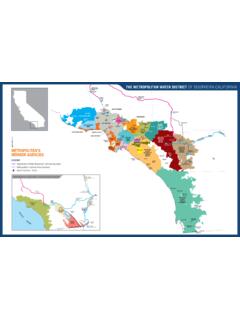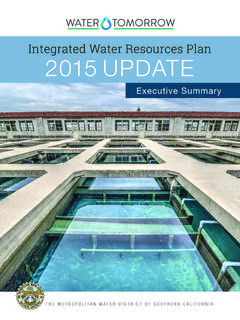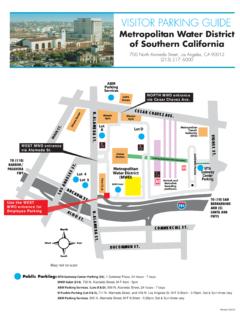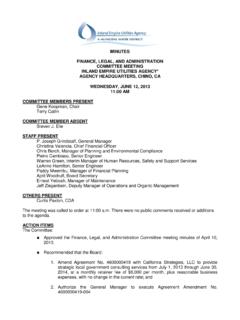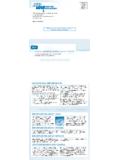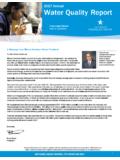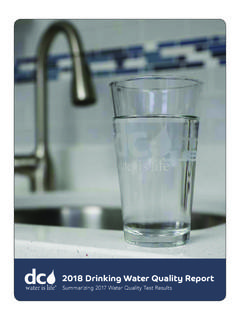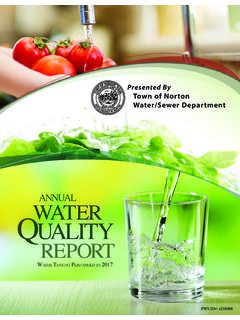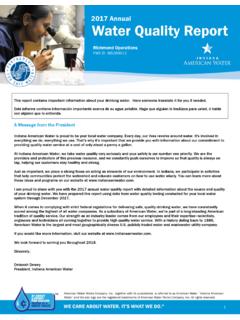Transcription of WATER QUALITY EXCELLENCE 2018 - Pages
1 Metropolitan s WATER QUALITY is equal to or better than what is required to safeguard public health. Read this report to learn more about WATER provided by Metropolitan, how it compares favorably to all drinking WATER standards, and what is being done to further protect nearly 19 million Southland METROPOLITAN WATER DISTRICT OF SOUTHERN CALIFORNIAANNUAL drinking WATER QUALITY report Covering the reporting period of January - December 2017 WATER QUALITY EXCELLENCE 2018A Letter From The General ManagerMetropolitan is a regional wholesaler that provides WATER for 26 member public agencies to deliver either directly or through their sub-agencies to nearly 19 million people living in Los Angeles, Orange, Riverside, San Bernardino, San Diego and Ventura counties.
2 The district imports WATER from the Colorado River and Northern California to supplement local supplies, and helps its members develop increased WATER conservation, recycling, storage and other resource-management River WATER is conveyed via Metropolitan s 242-mile Colorado River Aqueduct from Lake Havasu on the California-Arizona border, to Lake Mathews near Riverside. WATER supplies from Northern California are drawn from the crossroads of the Sacramento and San Joaquin rivers. They are transported in the State WATER Project s 444-mile California Aqueduct and serve urban and agricultural customers in the San Francisco Bay Area, as well as Central and Southern mark the completion of Metropolitan s conversion to ozone disinfection in 2017, this year s annual drinking WATER QUALITY report features images of ozone facilities at all five of Metropolitan s WATER treatment Letter From The General ManagerOn behalf of the Metropolitan WATER District of Southern California.
3 I am pleased to present this annual drinking WATER QUALITY report which provides a summary of WATER QUALITY and monitoring data for has been a national leader in providing safe drinking WATER that meets increasingly stringent standards. In 2017, that leadership was complemented by Metropolitan s ongoing efforts to improve the QUALITY and reliability of WATER supplies imported via the Sacramento-San Joaquin Delta and the Colorado River, and Metropolitan s support of WATER QUALITY initiatives within its six-county service area. The year was highlighted by the conversion of the Weymouth WATER Treatment Plant to ozone disinfection, a more effective treatment process, capping a $ billion initiative that had previously switched Metropolitan s Henry J.
4 Mills (2003), Joseph Jensen (2005), Robert A. Skinner (2010) and Robert B. Diemer (2015) plants to ozone technology. This systemwide achievement improves and protects the QUALITY of drinking WATER served to Southern California and has driven disinfection byproduct levels in Metropolitan s system to historically low help ensure the delivery of a safe and reliable WATER supply to the nearly 19 million people in its service area, Metropolitan tests its WATER for almost 400 constituents and performs nearly 250,000 WATER QUALITY tests annually on samples gathered throughout its vast distribution system.
5 Analyses of these samples are undertaken at Metropolitan s WATER QUALITY laboratory in La Verne. A core feature of this report is a detailed table that begins on page 10, which illustrates monitoring results. Additionally, a Readers Guide is included to help explain the data reported. To learn about other WATER QUALITY and supply issues, visit Metropolitan s website at and go to the About Your WATER section. You may also contact Dr. Mic Stewart, Metropolitan s Manager of WATER QUALITY , at or s Board of Directors typically meets on the second Tuesday of each month at the district s downtown Los Angeles headquarters building at 700 N.
6 Alameda Street, Los Angeles, adjacent to historic Union Station. More information is available at trust you will find this report to be ,Jeffrey KightlingerGENERAL Weymouth WATER Treatment Plant | Ozone generator drinking WATER and Your HealthDrinking WATER , including bottled WATER , may reasonably be expected to contain at least small amounts of some contaminants. The presence of contaminants does not necessarily indicate that the WATER poses a health risk. More information about contaminants and potential health effects can be obtained by visiting the Environmental Protection Agency s website at sources of drinking WATER (both tap WATER and bottled WATER ) include rivers, lakes, streams, ponds, reservoirs, springs and wells.
7 As WATER travels over the surface of the land or through the ground, it dissolves naturally-occurring minerals and, in some cases, radioactive material, and can pick up substances resulting from the presence of animals or from human J. Mills WATER Treatment PlantWater agencies are required to use the following language to discuss the source of contaminants that may reasonably be expected to be found in drinking WATER , including tap WATER and bottled contaminants, such as viruses and bacteria, that may come from wastewater treatment plants, septic systems, agricultural livestock operations and wildlifeInorganic contaminants, such as salts and metals, that can be naturally-occurring or result from urban stormwater runoff industrial or domestic wastewater discharges, oil and gas production.
8 Mining or farming Pesticides and herbicides that may come from a variety of sources such as agriculture, urban stormwater runoff and residential uses Organic chemical contaminants, including synthetic and volatile organic chemicals, that are byproducts of industrial processes and petroleum production, and can also come from gas stations, urban stormwater runoff, agricultural applications and septic systemsRadioactive contaminants that can be naturally-occurring or be the result of oil and gas production and mining activitiesIn order to ensure that tap WATER is safe to drink, the Environmental Protection Agency and the State WATER Resources Control Board, Division of drinking WATER , prescribe regulations that limit the amount of certain contaminants in WATER provided by public WATER systems.
9 California Department of Public Health and Food and Drug Administration regulations also establish limits for contaminants in bottled WATER that provide the same protection for public that may be present in source WATER include:3 Robert B. Diemer WATER Treatment PlantProtecting WATER QUALITY at the Source Source WATER protection is an important issue for all of California. Large WATER utilities are required by the DDW to conduct an initial source WATER assessment, which is then updated through watershed sanitary surveys every five years. Watershed sanitary surveys examine possible sources of drinking WATER contamination and recommend actions to better protect these source waters.
10 The most recent surveys for Metropolitan s source waters are the Colorado River Watershed Sanitary Survey 2015 Update, and the State WATER Project Watershed Sanitary Survey 2016 waters used by Metropolitan the Colorado River and State WATER Project each have different WATER QUALITY challenges. Both are exposed to stormwater runoff, recreational activities, wastewater discharges, wildlife, fires and other watershed-related factors that could affect WATER QUALITY . Treatment to remove specific contaminants can be more expensive than measures to protect WATER at the source, which is why Metropolitan and other WATER agencies invest resources to support improved watershed protection Advisory for People with Weakened Immune Systems Although Metropolitan treats WATER to meet drinking WATER standards, some people may be more vulnerable to contaminants in drinking WATER than the general population.
